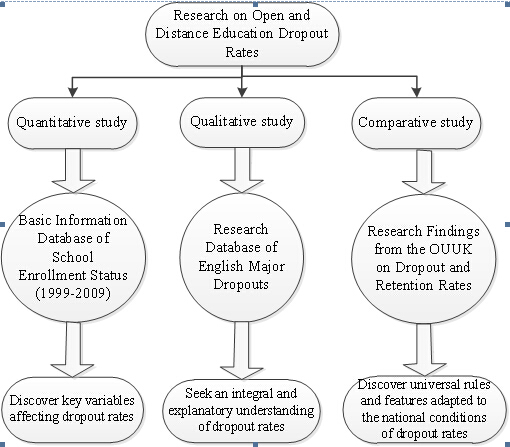III. Research Design and Approach
To fulfill the research objective, three approaches have been designed for the project: quantitative study, qualitative study and international comparison study. The focus of the large sample quantitative study is to discover the key variables affecting dropout rates and to identify effectively high-risk dropout learners. The focus of the qualitative study is to conduct a thorough analysis of learners, attempting to find an integral and explanatory understanding of dropout rates. The focus of the comparative study of open universities in China and UK is to discover how dropout rates are adapted to national conditions and if there are any universal rules. The quantitative study is supported by the 1999-2009 Basic Information Database of School Roll Status set up for the project. The qualitative study is based on interviews as part of the Research Database on English Major Dropouts. The comparative study comes from Simpson’s research findings on dropout and retention rates from OUUK.
1. Basic Information Database on School Enrollment Status (1999-2009): Following CCRTVU’s distribution pattern of 44 provincial radio and TV universities (RTVUs), a university in Central China was chosen as a sample for analysis. A total of 238,459 records were chosen from the provincial RTVU academic affairs management system database, so as to establish the Basic Information Database on School Enrollment Status (1999-2009), including school enrollment status from the spring of 1999 to the autumn of 2009. This serves as the database foundation and as a research guarantee for a large sample quantitative study of dropout rates.
2. Research Database of English Major Dropouts: Initial exploratory study outcomes show that dropouts mainly occur in the first three semesters after entrance, after which point the students tend to stabilize (Li Ying, 2009). Data mining from the sample described in point 1 above shows that over 21 enrollment semesters across 11 years, the English programme has the highest dropout rate of all other CCRTVU majors. Thus the English major was chosen as a sample for follow-up research. The follow-up study is made of 2237 new students recruited in the spring semester over the course of the following three semesters. It is usually difficult to contact the students once they drop out, but by adopting the follow-up study methodology, this difficulty can be effectively removed. At the same time, the research team can further decide the characteristics of the dropouts for each semester by comparing the dropouts across the three semesters. At the end of the study, 270 of the total 398 dropouts in the three semesters filled in an online questionnaire and 156 of them were interviewed. 72 interviews with teachers and 52 interviews with class teachers in the English programme were also conducted. The Research Database on English Major Dropouts is formed from the above information, as well as a large number of interviews. The underlying causes and patterns of dropout rates can further be analyzed through the used of the qualitative analysis software NVivo9.
3. Research findings from the OUUK on dropout and retention rates: The OUUK is a world famous open and distance university; the OUC is the world’s largest open university. Ormond Simpson is a renowned expert in international distance education, former director of the OUUK’s Centre for Teaching Instruction and Learning Support, and an expert on dropout rates and learning support. His research findings were used to support the comparative study between open universities in China and UK. Figure 1 shows the design and approach of the research project.

Figure 1 Design and Approach of Research on Open and Distance Education Dropout Rates